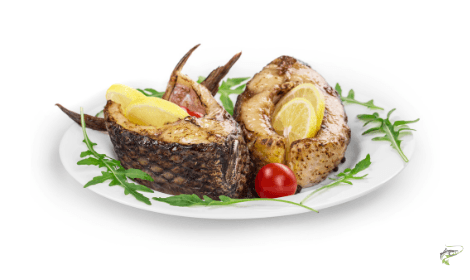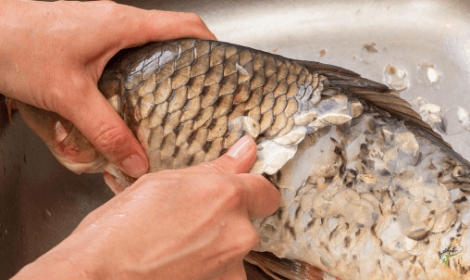
In the UK and across Europe carp are highly regarded as an excellent sport fish and there are hundreds if not thousands of venues stocked to the brim with carp.
Unlike trout fisheries, which are also abundant across the UK and Europe, these carp fishing venues are built purely for catch and release sport fishing.
But why is this?
Why is carp eaten across Europe and some parts of Asia but is strictly avoided in the UK?
To get to bottom of this in this we are going to explore the question of “Are Carp Edible?” to find out why the carp family is viewed so much differently across the world in terms of edibility.
The short answer is YES carp are 100% edible and if cooked and prepared correctly can actually provide a tasty meal.
In European countries such as Poland, Slovakia and the Czech Republic carp is traditionally eaten for Christmas dinner even to this day some families will purchase a carp and keep it alive in a bucket or bath until Christmas where it is cooked and eaten.
I think I’ll stick to turkey.
In this post I’ll take a look at the background of the carp family, where they originated from and how countries across the world view these fish in massively contradicting ways.
I’ll also give you some in-depth information of the taste of these carp, how they should be prepared properly and even provide a recipe that you can try for yourself if you are feeling bold.
When did people start eating carp?
The common carp is native to Europe and Asia but has been introduced into near enough every part of the world and has actually been farmed for food dating back to as far as Roman times.
As we know nowadays in the UK this is not the case as carp are primarily stocked for the satisfaction of us anglers but although carp are highly thought of as sport fish in Europe they quite often take their catch home for dinner.
Carp farming was especially found in monasteries in around the 14th-15th century as carp had become a prize source of protein during fasting periods of Christians.
During this time selective breeding took place where the finest robust, fleshy and long living fishing were bred together which has in turn produced the carp we know today.
There are many different types of carp bred in these times and you can read of some of them in this post on the types of carp commonly found in the UK.
In the 19th century pond breeding began across Europe to provide food for the population where they are still very much part of the populations diet.
This is very different from the UK as the consumption of carp seems to have completely dissipated to make way for sport fishing.
It is thought that around 2.3 million anglers fish for carp in the UK but you very rarely hear of people eating their catch as it is very much frowned upon or even illegal.
In China and parts of Asia carp has been reared for over 2000 years for a protein rich food source which has continued into the modern era where carp can found in many markets, stores and menus.
So what about the US? Well that’s a completely different story once again.
Carp across the US have an extremely bad reputation in terms of fishing and more so as a food source. Nearly all bodies of water across the US have become an extreme nuisance across the states as they breed rapidly in their water ways.
In many cases people will bow fish for carp in an effort to limit their numbers and for sport but there will definitely not be a consideration of taking them home for dinner.
If you would like to learn how to catch these fish then take a read at my post on how to carp fish.
As you can see the view of carp is widely different across the world but carp as a food source is still very much common and some parts so could the US begin to promote the consumption of carp to tackle this invasive species?
What does carp taste like?

If you are considering giving carp a taste I’m sure you’re going to know what it tastes like. As carp is not commonly eaten in UK and US cultures the answer may change whoever you ask. How carp tastes will depend on where it has come from, how it was prepared and how it is cooked.
A well-prepared carp from a clean waterway is often thought to have a taste not dissimilar to salmon or even catfish.
Carp is an oily fish which can have a massive effect on how the fish will taste once cooked and this can give it a taste that is described by a lot of people as “muddy”.
When carp is cooked properly the meat will be white, flaky and generally can be relative tasty without an overpowering “fishy” flavour.
By putting your catch straight into an ice bucket as soon as possible after catching the blood flow into the rib meat will be limited which aids in preserving the good flavours and taking out the bad.
As carp eat a lot of vegetation in water ways they tend to ingest a lot of pollution if the water quality they are living in is poor. This will have a massive impact on the flavour of the fish so if you plan on eating your catch make sure you are catching it from a clean water source to avoid any bad flavours.
The blood line that make up the carps lateral lines should be taken out before cooking the fish as this is what gives the carp the muddy and fishy flavours that you should be looking to avoid.
As mentioned before the Europeans who eat carp for Christmas dinner have a few tricks for reducing this muddy flavour and ensuring the carp meat is as tasty as possible.
By keeping the fish alive for a while in fresh water can completely remove this muddy taste throughout the meat but the blood line should still be very much avoided.
Older and more mature fish will generally be a lot larger and their flavour may be a lot stronger than small juvenile fish but this does not mean they should not be consumed.
One major issue with consuming carp is the bones. These fish have many tiny rib bones that can be found all throughout the filet which can be extremely unappetizing in a lot of case.
The consensus though is that carp can taste great if you can get past the bones in the filet!
How to Prepare Carp for Cooking?
Descaling

Just like any other fish the preparation phase is essential in preparing the fish for cooking and to ensure as much good meat is filet and all the foul tasting parts removed.
Carp scales are rather large compared to other fish species and can be quite a pain to remove them all. To start descaling the fish press a large sharp knife firmly against the tail of the carp and start to work your way towards the head of the fish keeping pressure until all the scales are removed.
Your knife should stay pressed under the scales as you move up towards the head of the carp which should remove the scales in the process.
After descaling rinse the fish thoroughly to remove any scales stuck to the body and to clean the carps body.
This way for descaling the carp can be messy and quite challenging as the scales are extremely large and tough.
Another way you can descale your fish is to cut slightly under the skin and scales near the tail of the carp. You should then follow the back bone of the fish and cut the skin away underneath the scales.
After this step you will need to be make a shallow cut along the belly of the fish to free the skin. After this you can start to peel away the skin and scales and cut any skin that is still stuck to the body of the fish.
This can be a far quicker and cleaner way of descaling but definitely takes some skill and an extremely sharp knife.
Filleting
The next step is to remove the fillets from the body of the fish while avoiding or removing the foul tasting blood line. Make sure you use an extremely sharp knife for this step.
Press your knife behind the gills of the fish and run the knife along the back bone until you reach the tail. Your knife should run along the thick ribs of the carp which should guide you through the cut.
You should try to filet your fish as close to the backbone as possible to savour the most tasty meat.
Once this has been completed on both sides and the fillets removed the next step is to remove the blood line. This is the set of nerves that make up the fishes lateral line which you will see as a dark line on the fillets. Simply cut this off and make sure there is no more bloodline left on your meat.
Unfortunately it is very difficult to filet a carp without leaving in a lot of bones so this is something you will need to keep in mind when eating the fish.
After filleting you should wash the fillets again thoroughly and either cook quickly or place them back on ice to avoid changing the flavour.
That’s it!
It is extremely strange how carp are viewed across the world from a massive sport fish in the UK and across Europe to being classed as a complete “trash” fish in the US.
In a lot of place across Europe and in Asia carp are commonly consumed and I’m sure you can now see that yes carp are very much edible and can actually taste quite nice.
I highly doubt carp will ever make there way into American cuisine but this definitely could help slightly in reducing the massive populations of these invasive fish across the country.
If you have tried carp before and would like to add some extra information then feel free to leave a comment below and I will get back to you ASAP!

